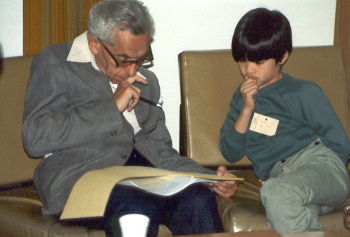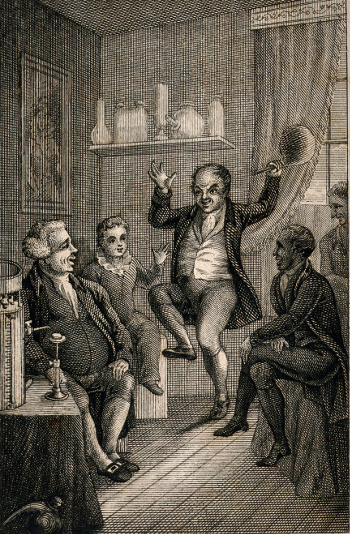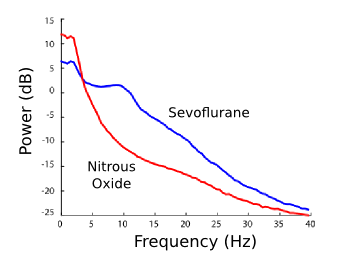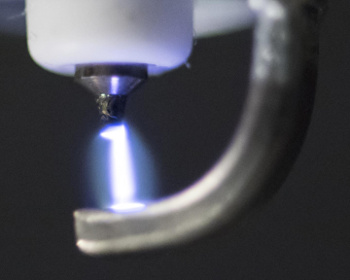Nitrous and Nitric Oxides
August 3, 2015
Mathematics, like
physics and
chemistry, is subdivided into many
specialties. Generally,
practitioners in any one of these has only a cursory understanding of what's happening in the others. While most
inorganic chemists can render the
periodic table of the
elements from memory, this would be a hard task for an
organic chemist. Likewise,
condensed matter physicists can't recite the members of the particle zoo discovered by their
particle physics
counterparts.
Likewise, mathematics is fragmented into many fields. You can view a list of the
fields of mathematics on the
arXiv topic page. While most
mathematicians are knowledgeable just in their specialty area,
Paul Erdős was a true "poly-math," since he made contributions to so many fields of mathematics.
As was his custom, Erdős mostly
collaborated with others, thereby inspiring the concept of the
Erdős number, which is the "collaborative distance" between Erdős and another person. A
coauthor of a paper with Erdős has an Erdős number of one, while a coauthor of a coauthor with Erdős has an Erdős number of two, etc.

Paul Erdős and ten year old Terence Tao in 1985.
Tao, whose work I presented in a previous article, has an Erdős number of two.
(Via Wikimedia Commons.)
While Erdős was facile in many areas of mathematics, he was often confronted with a procedural problem when talking with
colleagues. Mathematics is like a
Tower of Babel in which each specialty has its own
nomenclature. Nomenclature is important, since it provides a shorthand way of expressing deep concepts. By asking his colleagues to define their
jargon, he was able to see the mathematics lurking in a problem. Although he likely didn't admit it, this was also the Erdős' method of
professional development in which his colleagues were his
teachers.
Chemists have a nomenclature for naming some of the simple
inorganic compounds. Compounds formed from
cations at their lowest
valence are "-ous," and compounds with the next highest valence are "-ic." That's why we have
ferrous chloride, FeCl2, a.k.a. iron(II) chloride, and
stannous chloride, SnCl2, a.k.a. tin(II) chloride, but also
ferric chloride, FeCl3, a.k.a. iron(III) chloride, and
stannic chloride, SnCl4, a.k.a. tin(IV) chloride.
The same is true for two principal
oxides of
nitrogen,
nitrous oxide, N2O and
nitric oxide, NO. Nitrous oxide is familiar to everyone as "laughing gas." Nitrous oxide, a once common
anesthetic in dentistry, has an
euphoric effect that lends itself well to
comedy. There's a 1914
Keystone Studios film called
Laughing Gas, in which
Charlie Chaplin is both an
actor and the
director.[1]

An engraving entitled, "Chemical Recreations." This shows nitrous oxide inducing laughing and dancing.
English chemist, Joseph Priestley (1733-1804), discovered nitrous oxide in 1772, and named it phlogisticated nitrous air. He prepared it by heating iron filings and nitric acid.
(Illustration from Wellcome Images, a website operated by Wellcome Trust, a global charitable foundation based in the United Kingdom, via Wikimedia Commons.)
Although nitrous oxide has been used as an anesthetic since the 1880s, the affect of nitrous oxide on
brain function has surprisingly never been thoroughly studied. Now, a team of
scientists from
Massachusetts General Hospital (Boston, Massachusetts),
Harvard Medical School (Boston, Massachusetts), and the
Massachusetts Institute of Technology (Cambridge, Massachusetts), have used
electroencephalography (EEG) to study the key
brainwave changes that occur in
patients on nitrous oxide.[2-3]
Nitrous oxide is commonly administered near the completion of
surgery as a way to keep a patient
unconscious while a primary
ether anesthetic clears from the patient's system.[2-3] It's administered, also, in combination with an ether anesthetic during surgery as a way to reduce the ether dose.[3] The
research team measured brain activity by the EEG technique in which six
electrodes are placed on the
forehead to measure the brain's
electrical activity. The brain's
voltage signals are a result of the collective activity of brain
neurons communicating with each other.[3]
Nineteen patients were studied. They received general anesthesia using
sevoflurane, an ether anesthetic, combined with
oxygen and
air.[2] When the anesthesia was transitioned to nitrous oxide, the brain's
alpha oscillations (8–12 Hz) associated with sevoflurane dissipated within about six minutes, to be replaced by a highly-coherent large-amplitude
slow-delta oscillation (0.1–4 Hz) that persisted for about three minutes.[2] Such delta waves are characteristic of
deep sleep, but the delta waves induced by nitrous oxide had twice the
amplitude.[3]

EEG spectra under a sevoflurane ether (blue) and nitrous oxide (red) anesthetic. The excess of low frequency delta waves is clearly see.
(Fig. 2c of ref. 2, modified for clarity, licensed under a Creative Commons License.)
These findings stand in contrast to the brain activity observed with lower
concentrations (20-40%) of nitrous oxide at which it's a
sedative and not an anesthetic. At those levels,
beta oscillation are found and the delta wave amplitude decreases, instead.[2-3] Says
Emery Brown, a
professor of
Medical Engineering at MIT and an
anesthesiologist at Massachusetts General Hospital,
"We literally watched it and marveled, because it was totally unexpected... Nitrous oxide has control over the brain in ways no other drug does."[3]
The reason that the delta waves are increased just at the start of dosing, and then fall-off, is unexplained. The researchers suspect a rapid
habituation or
desensitization process.[3] The research team is presently investigating how all principal anesthetics and anesthetic combinations affect the EEG signatures.[3]
The nitric oxide cousin of nitrous oxide also has a
medical application. Inhaled nitric oxide relaxes
pulmonary vessels without causing a
systemic drop in
blood pressure. The effect, discovered in 1999, is now used to treat about 35,000 U.S. patients in
hospitals each year, some of whom are
newborns with a condition called
persistent pulmonary hypertension of the newborn (PPHN).[5] Nitric oxide
therapy for PPHN, which takes about five days, costs about $14,000. Much of the cost arises from distribution and handling of
gas cylinders, and the associated delivery and
monitoring devices.[4-5]
Another team of researchers at the Massachusetts General Hospital of
Harvard Medical School (Boston, Massachusetts) has developed a simple device that uses a
pulsed electrical discharges to produce nitric oxide in the therapeutic range of 5-80
parts per million at carrier gas
flow rates of 0.5-5
liters/
minute. The nitric oxide is produced from the air, or from
gas mixtures of 90% O
2 and 10% N
2 (see photo).

An electrical spark generating therapeutic nitric oxide from the air
Iridium was found to be the best electrode material for this application.
(Photo by Brian Wilson, Massachusetts General Hospital Photography Department.)[5)]
The
electrical spark produces potentially
toxic gases, including
nitrogen dioxide (NO
2) and
ozone (O
3), but these are removed by flowing the gas through
calcium hydroxide.[4-5]
Iridium electrodes were found to produce the highest
ratio of nitric oxide to nitrogen dioxide.[4] Other
optimizations included finding the optimal timing and number of electric sparks.[5]
patent applications have been filed on this system, and a
startup company is looking to
commercialize this.[5]
References:
- Laughing Gas (1914, Charles Chaplin, Director) on the Internet Movie Database.
- Kara J. Pavone, Oluwaseun Akeju, Aaron L. Sampson, Kelly Ling, Patrick L. Purdon, and Emery N. Brown, "Nitrous oxide-induced slow and delta oscillations," Clinical Neurophysiology, Article in Press, DOI: http://dx.doi.org/10.1016/j.clinph.2015.06.001. This is an open access publication with a PDF file available here.
- Uncovering the mechanism of our oldest anesthetic, MIT Press Release, July 6, 2015.
- Binglan Yu, Stefan Muenster, Aron H. Blaesi, Donald B. Bloch, and Warren M. Zapol, "Producing nitric oxide by pulsed electrical discharge in air for portable inhalation therapy," Science Translational Medicine, vol. 7, no. 294 (July 1, 2015), pp. 294ff., DOI: 10.1126/scitranslmed.aaa3097.
- Mass. General team generates therapeutic nitric oxide from air with an electric spark, Massachusetts General Hospital Press Release, July 6, 2015.
Permanent Link to this article
Linked Keywords: Mathematics; physics; chemistry; specialty; practitioner; inorganic chemistry; inorganic chemist; periodic table; chemical element; organic chemistry; organic chemist; condensed matter physics; particle physics; areas of mathematics; fields of mathematics; arXiv topic page; mathematician; Paul Erdős; collaboration; collaborate; Erdős number; author; coauthor; Terence Tao; Wikimedia Commons; colleague; Tower of Babel; nomenclature; jargon; professional development; teacher; inorganic compound; cation; valence; ferrous chloride, FeCl2; stannous chloride, SnCl2; ferric chloride, FeCl3; stannic chloride, SnCl4; oxide; nitrogen; nitrous oxide, N2O; nitric oxide, NO; anesthesia; anesthetic; nitrous oxide euphoric effect; comedy; Keystone Studios; Laughing Gas; Charlie Chaplin; actor; director; engraving; laughter; dancing; English; chemist; Joseph Priestley (1733-1804); phlogiston theory; phlogisticate; iron filings; nitric acid; Wellcome Images; Wellcome Trust; brain function; scientist; Massachusetts General Hospital (Boston, Massachusetts); Harvard Medical School (Boston, Massachusetts); Massachusetts Institute of Technology (Cambridge, Massachusetts); electroencephalography; brainwave; patient; surgery; unconsciousness; unconscious; ether; research; electrode; forehead; electricity; electrical; voltage; signal; neuron; sevoflurane; oxygen; air; alpha wave; alpha oscillation; delta wave; slow-delta oscillation; slow-wave sleep; deep sleep; amplitude; EEG; spectral density; spectra; sevoflurane ether; Creative Commons License; concentration; sedative; beta wave; beta oscillation; Emery Brown; professor; Medical Engineering; anesthesiologist; habituation; desensitization; medicine; medical; lung; pulmonary; blood vessel; systemic; blood pressure; hospital; infant; newborn; persistent fetal circulation; persistent pulmonary hypertension of the newborn; therapy; gas cylinder; sensor; monitoring device; Harvard Medical School (Boston, Massachusetts); pulse; pulsed; electrical discharge; parts per million; fluid dynamics; flow rate; liters/minute; gas mixture; electrical spark; nitric oxide; iridium; material; Brian Wilson; electric spark; electrical spark; toxicity; toxic; nitrogen dioxide; ozone; calcium hydroxide; ratio; optimization; patent applications; startup company; commercialization; commercialize; Laughing Gas (1914, Charles Chaplin, Director).